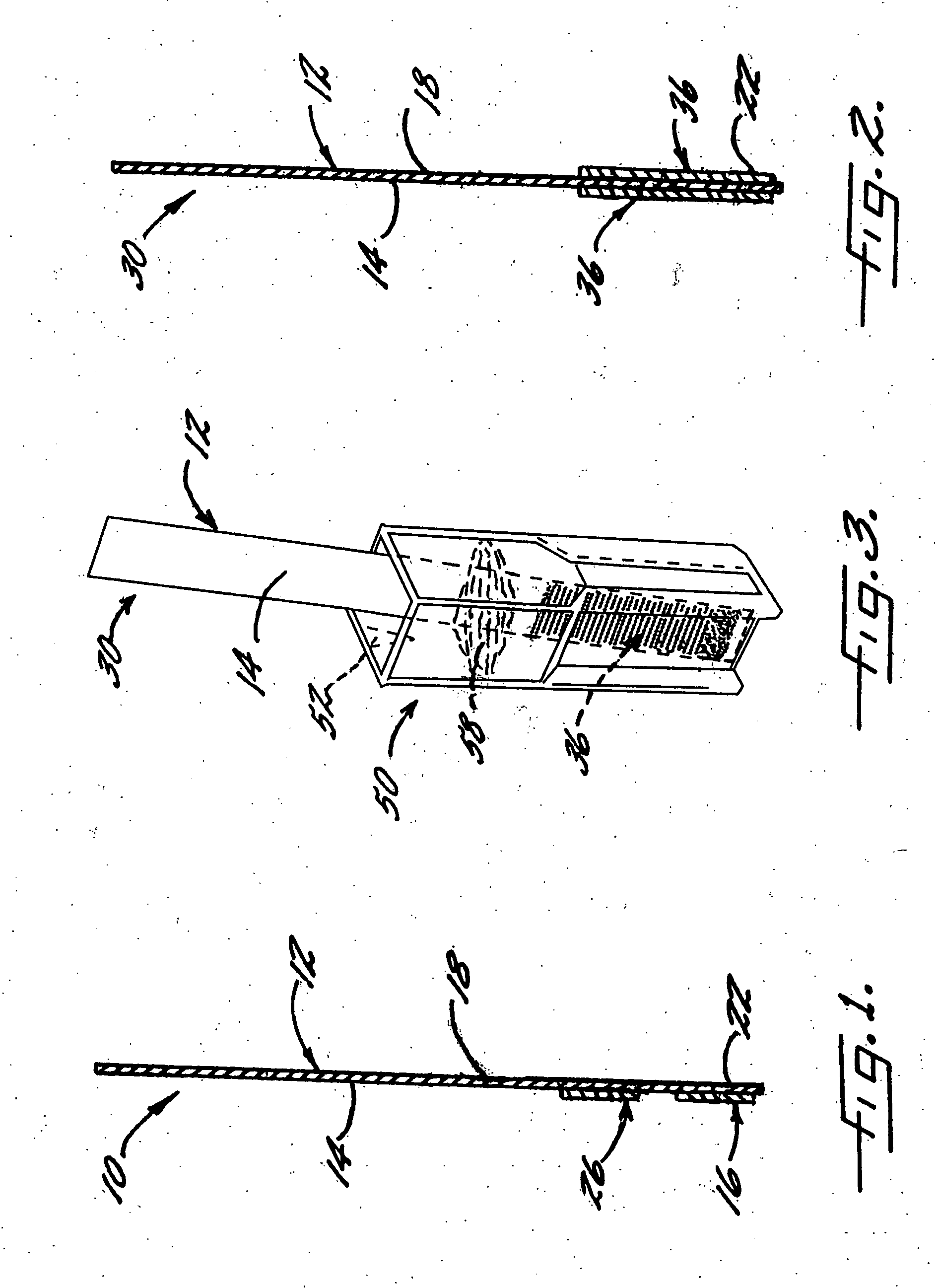Reagent delivery device and method
a technology of reagent delivery and reagents, applied in the field of colorimetric analysis, can solve the problems of inability to conduct colorimetric cyanide analysis chemistry, inability to accurately determine cyanide, and variability of measurements, so as to achieve rapid quantitative photometric analysis, reduce variability of measurements, and minimize manipulations
- Summary
- Abstract
- Description
- Claims
- Application Information
AI Technical Summary
Benefits of technology
Problems solved by technology
Method used
Image
Examples
example 1
[0092] With reference again to reagent delivery device 10 of FIG. 1, in a convenient embodiment, support 12 is made of PVC, is 8 mm wide and has a thickness of 0.009 inches, and carriers 16,26 are each ½″ long and 8 mm wide. Carriers 16,26 are fibrous pads made of Schleicher and Schuell (S&S) 404 paper, and are attached near support end 22 by double-faced adhesive to face 14 of the support. To prepare pad 16, a 13 wt. % solution of chloramine-T hydrate in deionized water having a pH of 9.7, is used to impregnate S&S 404 paper. To prepare pad 26, a solution of 32.9 wt. % sodium phosphate monobasic and 5.6 wt. % sodium phosphate dibasic in deionized water having a pH of 4.7, is used to impregnate S&S 404 paper. S&S 404 paper has a thickness of approximately 0.2 mm, a water absorbency value of 1.4 g / 100 cm2, and a basis weight of approximately 80 g / cm2.
[0093] With reference again to reagent delivery device 30 of FIG. 2, in a convenient embodiment, support 12 is as previously described...
example 2
[0101] In this Example, reagent delivery devices 10,30 substantially correspond to those used in Example 1, except that S&S 8S paper is impregnated instead of S&S 404 paper, and used for carriers 36 of device 30. S&S 8S paper has a thickness of approximately 0.35 mm, a water absorbency value of approximately 2.4 g / 100 cm2, and a basis weight of approximately 50 g / cm2 The method of Example 1 is repeated using another 2 ml of the same cyanide standard.
[0102] Visual evaluation of the color of test pads 36 as before, and using the color chart calibrated for S&S 404 paper, reveals an intensified color and results in a determination of a cyanide value of 1.0 ppm. This elevated cyanide value indicates greater sensitivity using S&S 8S paper, instead of S&S 404 paper; and as can be understood by one skilled in the art, an accurate cyanide value of 0.5 ppm would be shown by a color chart calibrated for S&S 8S paper.
[0103] As before, after allowing color development of the liquid in the micr...
example 3
[0106] In this Example, reagent delivery devices 10,30 substantially correspond to those used in Example 1.
[0107] In an application of the preferred photometric method and referring to FIGS. 5 and 6, another 2 ml of the same cyanide standard is added to another microcuvette 50, and the outside of microcuvette 50 is wiped to be clean and dry. Referring particularly to FIG. 5, the microcuvette is then inserted into the cell chamber of a CO7500 Colorimeter using mark 52 (shown in FIG. 6) as a guide, and photometer 60 is zeroed.
[0108] Thereafter, with microcuvette 50 remaining in photometer 60, the delivery end of reagent delivery device 10, is dipped repeatedly in the 2 ml cyanide standard as in Example 1, to deliver the analytical agents from pads 16,26 and provide a mixing action. Immediately after 30 seconds contact time with the 2 ml volume of cyanide standard, device 10 is withdrawn from microcuvette 50, and referring particularly to FIG. 6, beginning within 10 seconds, the deli...
PUM
 Login to View More
Login to View More Abstract
Description
Claims
Application Information
 Login to View More
Login to View More - R&D
- Intellectual Property
- Life Sciences
- Materials
- Tech Scout
- Unparalleled Data Quality
- Higher Quality Content
- 60% Fewer Hallucinations
Browse by: Latest US Patents, China's latest patents, Technical Efficacy Thesaurus, Application Domain, Technology Topic, Popular Technical Reports.
© 2025 PatSnap. All rights reserved.Legal|Privacy policy|Modern Slavery Act Transparency Statement|Sitemap|About US| Contact US: help@patsnap.com



